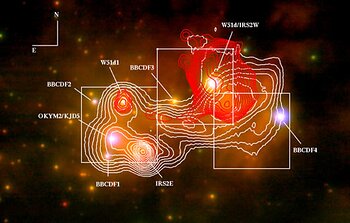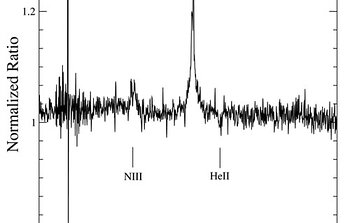Two Very Young Massive Stars Unshrouded with LGS AO
April 14, 2008

An international team led by Brazilian astronomer Cássio L. Barbosa (UNIVAP, Sao José dos Campos) employed the Gemini North Laser Guide Star (LGS) adaptive optics system Altair to probe deep into the core of star forming region W51. This is one of the most luminous complexes of massive star forming regions in our Galaxy.
W51 has two bright infrared sources: IRS1 and IRS2 which are coincident with known radio sources. The team used the Near-Infrared Integral Field Spectrograph (NIFS) to spectro-image three fields in IRS 2, which contains three ultra-compact HII regions: W51d, d1 and d2 (Figure 1). The spectral data cube they constructed allowed the researchers to reconstruct spectral maps at various wavelengths, providing key diagnostics on the composition and velocities of the stellar and gas components in this obscure but active region. The high angular resolution achieved by NIFS and Altair/LGS made possible the separation of the strong extended emission from the massive young stellar objects themselves.
IRS 2 is a site of intense star formation. It harbors some very massive stars still embedded in dust due their young age. A reconstructed spectrum of the ultra-compact HII region W51d/IRS2W shows a broad Brackett gamma emission line of ~700 kilometers/second, betraying fast winds coming from the hot ionizing star (Figure 2). The spectrum also shows the NIII multiplet and an helium-II line in absorption. This indicates a very early spectral type, as early as O3-4. Hence this star may be one of the most massive ionizing sources of an ultra-compact HII region known. The object is still buried in its opaque cocoon of dust.
For IRS2E, we seem to be seeing its photosphere. The detection of CO overtone emission suggests the presence of an accretion disc around IRS2E. The absence of radio emission and the accretion disk indicate that the source is a massive young stellar object (Figure 3).
The NIFS observations have revealed two very massive stars, close in space: one has cleared its surrounding material enough to probe its photosphere; the other in a younger phase is still deeply embedded in its dust cocoon and surrounded by a disk. This suggests that the evolutionary timescale of such very young massive objects may be as short as a few hundred thousand years.
Technical Note: Using NIFS/Laser Guide Star AO
The authors of this accompanying work on W51 IRS2 used the Gemini North Laser Guide Star system feeding the facility adaptive optics system Altair, because no bright optical source was available for AO correction. A faint star was available for optical tip-tilt correction at the edge of the Altair field of view and this combination was successful.
Because the star forming region IRS2 in W51 is extremely rich in dust, extinction is an important issue. The stars in the region are embedded and appear as fuzzy blobs as revealed by radio mapping and mid-infrared imaging (see Figure 1). Using the 3 x 3 arcsecond aperture of NIFS ensured that spectral mapping was sufficiently extensive to catch the massive object embedded in dust cocoons. Narrow slits could have easily missed the core of the sources.
For more details, see the article “High spatial resolution spectroscopy of W51 IRS2E and IRS2W: two very massive young stars in early formation stages”, by Cássio L. Barbosa et al. 2008, in the May 1st edition of The Astrophysical Journal Letters, 678, L55



